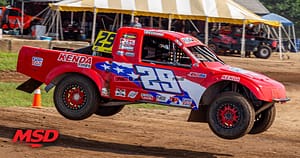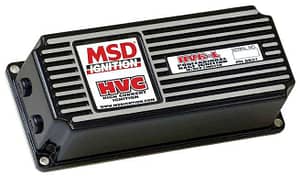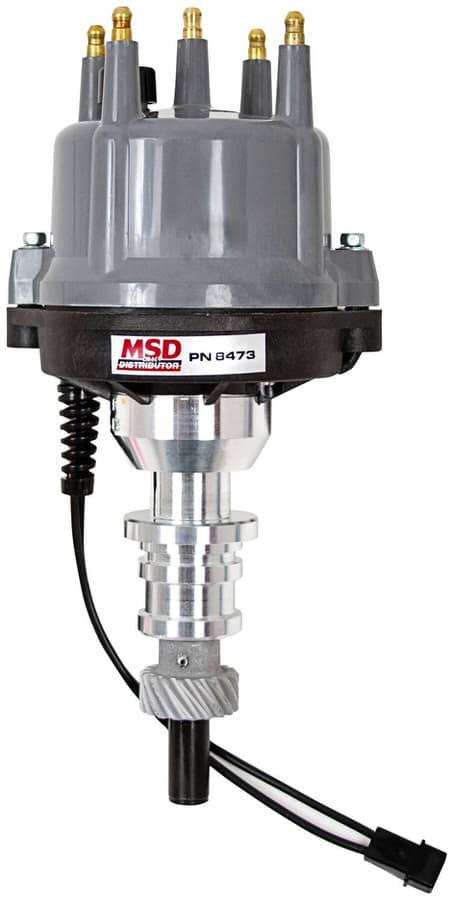MSD Ignition
With MSD Ignition, you can optimize the power sent to your ignition system. Choose between ignition boxes that dial in your engine’s every spec, distributors to maximize where your energy is going and ignition coils to dial in your spark energy.
The power of your engine can be magnified with parts that work hard for your engine’s best potential. MSD packs that punch you have been looking for.
Ignition Box
Boost your spark with an MSD Ignition ignition box. Dial in your revs, max RPM and boost your engine in countless ways with these revolutionary tools. The functionality of your vehicle on the track is a science and now you can digitize your ignition control, specs, customize options where you want them and choose different options for your engine’s fuel type. Timing control is now at your fingertips to make your racecar the highest performing possible.
Distributors
MSD distributors are a breeze to install and come in three types:
Max-Fire, Unilite and E-Fire. Drop the part right into place and enjoy
the efficiency of how well the part distributes energy from the ignition
system.
Ignition Coil
Dial in your power with the perfect ignition coil for your engine. You can increase your capacity for spark energy with greatly improved performance. The spark energy delivery is unmatched with any MSD ignition coils.

The History of Drag Racing
Drag racing is at the heart of MSD. The rich history of the sport hails from the West Coast – where all things cool seem to erupt.

Often thought of as an underground sporting event, drag racing has become a worldwide phenomenon, putting the sport on the map in a big way. In the early days, drag racing was an underground sport, but the advent of sanctioned racing courses, big name companies and huge money prizes put the sport on the national map.
Drag racing is a side-by-side racing competition where two contestants race side-by-side on a drag strip. A drag strip is typically a straight racing track with a minimum distance of about 1320 feet. Most drag strips are built on flat, artificially-constructed tracks. The winner is determined by the speed of the two vehicles and the elapsed time.
The first official drag race took place in Goleta, California in 1949. The race elicited the attention of Wally Parks, who served as the first President of the National Hot Rod Association. He called for a national organization to oversee drag racing and later became the editor of Hot Rod magazine.
The first commercial drag strip opened in Santa Ana, California in 1950. The strip was a formerly unused runway, and the first drag race was held on the track. It is believed that a few fans of the growing competition devised the rules and regulations of drag racing.
Another first was the use of a stopwatch to measure the fastest speed of the cars. Another first was the use of a bracket racing system to determine the fastest time. This system, which was developed by Ron Leek of Byron Dragway in Illinois, was invented to boost the grassroots competition.
Aside from the obvious, a more technical change came in 1963, when nitro-methane was banned. This was the era of the “slingshot”, a purpose-built front-engine dragster. Another milestone was the use of electronic lighting instead of flagmen.
The history of drag racing is a complex one. One theory is that it came from the challenge of driving a car through a series of gears. Another theory is that it was the challenge of finding the fastest way to drive through a straight line. However, most people are still at a loss as to why this race is called a drag race.
The most important rule is that a drag race is not for the faint of heart. The only paved section in smaller towns was on the main drag. Nevertheless, drag racing is a sport for the fast and the furious. It may not be for the faint of heart, but it does bring car enthusiasts together and puts the sport on the map.

The NHRA has since spawned multiple national events across the United States. It has also spawned a top-tier category for motorcycle drag racing, referred to as Pro Stock Motorcycle. This category is a blend of high performance and brand identification.
The National Hot Rod Association also ran HOT ROD magazine, which discussed a variety of interesting topics, including the history of drag racing. The association has hosted more than a thousand events across hundreds of race tracks and is credited with legitimizing the sport. It also introduced safety standards, and produced the first national magazine about the sport.
Ignitions Explained
MSD ignitions are one of a kind, but the mechanics of an ignition are pretty universal. Uzbasic Motorsports welcomes you to read on and discover all there is to know about ignitions and we recommend you try out MSD for a great product experience.
The ignition system in your car is responsible for starting the vehicle. It is an electrical system which delivers high voltage to the spark plugs when the engine is at the top of the compression stroke. When the spark is triggered, the fuel mixture ignites and pushes the piston down. Eventually, the combustion process ends and the engine is shut off.
The ignition system is a simple circuit which is composed of two main components. First is the coil, which converts volts of electrical energy into a high 20,000+ volt charge. Next is the distributor, which directs the charge to the correct spark plugs. Lastly, there is the rotor, which assists in the passage of current through the distributor.
The coil contains a primary winding circuit and a secondary winding circuit. The primary winding is made up of heavy copper wire which loops around the coil over 100 times. This insulated wire prevents the voltage from jumping from loop to loop. Normally, the voltage reaches about 20,000 volts. However, in some cases, it can reach up to 50,000 volts.
A magnetic field is created by the iron rod. Once the current stops, the magnetic field collapses. If it does not collapse, then the points can arc and cause a problem. To avoid a problem, the coil has a rubbing block that controls the opening and closing of the points. During most of the cycle, the points are closed.
During the ignition cycle, the coil makes a spark and jumps the gap between the rotor and the distributor post. This jump ignites the compressed air-fuel mixture. Since the gap is small, it requires a strong voltage to jump across it. In order to do this, the ignition system keeps the voltage across the points below a certain breakdown voltage for the air gap.
Several other components play an important role in the ignition system. These include the distributor, the contact breaker, and the rubbing block. Each of these components has its own relay that is responsible for controlling the associated components. Another relay is responsible for keeping the voltage across the points at a low level.
The primary circuit is designed to create a strong magnetic field within the coil. Several different relays are also used to control the components of the ignition system.
The secondary winding is connected to the rotor on the distributor shaft. The rotor arm is driven by the engine and spins past a series of contacts. This spinning action allows the current to flow through the distributor. At the same time, it helps to keep the magnetic field in the coil open. As the rotor spins, the current jumps from gap to gap
The ignition cycle can be very long and may last several seconds. However, it is very important to remember that the ignition system must deliver the spark to the right cylinder at the right time. There are several different types of ignition systems, including the electronic ignition system, which is less complicated.


